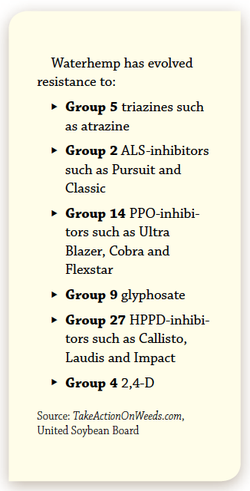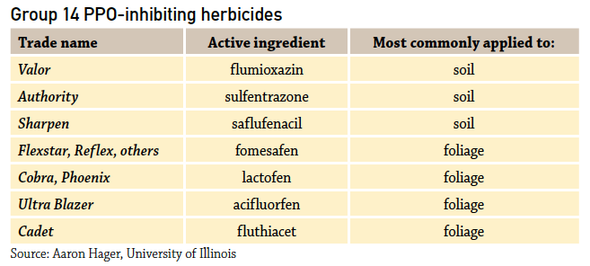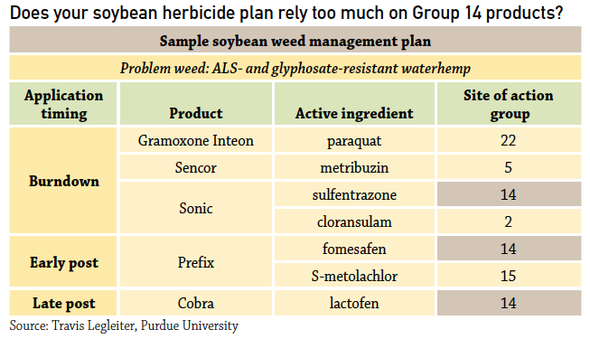
PPO stewardship is key to fight Group 14 herbicide resistance
Think DifferentNext season, growers in some states will have the choice to plant Dow AgroSciences’ Enlist soybeans, which are genetically engineered to be resistant to Enlist Duo herbicide, a combination of glyphosate and 2,4-D.The Enlist system – and other soybean traits in the pipeline, such as glyphosate- and dicamba-resistant soybeans – will give farmers additional postemergence herbicide choices in problem fields, says Mike Owen, Iowa State University weed scientist.But these new tools are not silver bullets for the herbicide-resistant pigweeds plaguing Midwest soybean growers, he says. “Unfortunately, expectations for these new technologies are a little overboard,” he warns. For example, “Neither 2,4-D nor dicamba is that consistent on waterhemp – not as effective as Group 14 herbicides, in many instances.”
January 20, 2015

The spread of multi-resistant waterhemp has led to increasing use of Group 14 herbicides, the protoporphyrinogen oxidase (PPO) inhibitors that include Cobra, Flexstar, Ultra Blazer and others. Repeated use is exerting intense pressure on this diverse group of chemicals, weed experts warn.
“As with any herbicide, the more you use it, the more likely you are to select for resistance,” says Mike Owen, Iowa State University weed scientist. “It’s like baseball: You only get so many swings at bat.”
Five Midwest states have now detected PPO-resistant waterhemp. “Group 14 resistance has become more prevalent,” says Aaron Hager, University of Illinois weed scientist. “Without a doubt, it will continue to increase.”
That’s alarming, because PPO herbicides are now the only postemergence option for killing glyphosate-resistant pigweeds in conventional and Roundup Ready soybeans. Many waterhemp populations are also resistant to Group 2 herbicides such as Classic and Group 5 herbicides such as atrazine.

Yet, as dire as this sounds, farmers are not out of options, Hager says. Resistant weeds can be managed through carefully integrated tactics, such as the following:
Applying full rates of preemergence residual herbicides that are effective on target weeds
Employing multiple modes of effective action
Spraying weeds when they’re small
Using cultural practices such as regular scouting, crop rotation and mechanical or hand weeding
“It’s not simple,” Hager says, “but stewardship is the best thing you can do.”
Evolving PPO resistance
Waterhemp has evolved resistance to herbicides from six classes, including Group 14 herbicides. PPO-resistant waterhemp has been confirmed in Kansas, Illinois, Missouri, Iowa and Indiana. Recent surveys in Missouri and Iowa found that about 10% of waterhemp samples were resistant to labeled use rates of Cobra or other Group 14 products. In Illinois, about 70% of waterhemp samples submitted for resistance screening in 2014 had overcome PPO inhibitors.
There are many Group 14 products labeled for soybeans, some of which are commonly applied to the soil and others to foliage. But they all share a common site of action. “If you have resistance to one of the foliar-applied Group 14 herbicides such as Flexstar, then almost certainly you have resistance to Cobra and Ultra Blazer as well,” says Kevin Bradley, University of Missouri weed scientist.

PPO-resistant waterhemp evolved in north central Missouri partly because growers didn’t understand that different products have the same site of action, says agronomist Chris Hoffman, GFG Ag Services, Trenton. “They thought that by switching from, say, Cobra (lactofen) to Ultra Blazer (acifluorfen), they were rotating chemistry.”
Another common misconception with PPOs is that resistance develops only to the foliar-applied products, Hager says. In fact, soil-applied herbicides also select for resistant biotypes.
The difference is that resistance to soil-applied herbicides takes longer to become apparent, because those chemicals are usually applied at higher rates in order to achieve several weeks of residual control. The higher rates “overcome the mechanism of resistance, at least for a while,” Hager says. But as the herbicide degrades in the soil, resistant plants survive and emerge, gaining a selective advantage. This “may partially explain the increasing frequency of PPO-resistant waterhemp populations in Illinois,” he says.
Hoffman says there is also evidence of this in north central Missouri, where soil-applied PPOs “are probably not working as well as before.”
Soybean growers respond
In response, soybean growers are using more Group 15 pre-plant, soil-residual herbicides such as Outlook or premixes such as Fierce or Authority Elite (Groups 15 and 14, respectively), Hoffman says. Some growers are also adding a residual herbicide to their early POST application, he notes.
Others are getting good waterhemp control with Group 3 herbicides such as Treflan with incorporation or Prowl, says agronomist George Soltwedel, Effingham Equity, Effingham, Ill. In the southern Midwest, more growers are rotating to Liberty Link soybeans, Bradley says. Growers could also consider diversifying their crop rotations or doing selective tillage in problem fields or portions of fields, Owen adds.
Carl, Eric and Mack Woodard raise corn and soybeans near Trenton, Mo. The Woodards have minimized resistant weed problems on their farm by crafting a diverse herbicide plan and paying careful attention to application timing and quality.
Several years ago, the Woodards, longtime no-tillers, shifted to Liberty Link soybeans on about 80% of their bean acres. This lets them hit emerged weeds with glufosinate, a Group 10 herbicide. “But we haven’t gotten totally away from Roundup Ready soybeans, and we hope not to,” Carl Woodard says. “We go back and forth.”

The Woodards apply preemergence residual herbicides on all their soybean acres. “We’ve been successful getting out in front of weeds,” Woodard says.
In 2014, their soybean weed plan included a burndown of glyphosate (Group 9), Sharpen (Group 14) and 2,4-D (Group 4). Because it was unseasonably warm early in the spring, they added a 2/3 rate of Zidua, a Group 15 residual herbicide with good activity on waterhemp. Just before or right after planting soybeans, they applied an additional 1/3 rate of Zidua to prolong residual activity.
About three weeks after planting, the Woodards made a planned postemergence application of Liberty or glyphosate, depending on the soybean variety. They try to avoid using Group 14 herbicides post, but “we have them to fall back on if needed,” Woodard says. This year, for the first time, they tank-mixed Warrant, a Group 15 residual herbicide, aiming to eliminate waterhemp emergence for the rest of the season, a practice called overlapping or layered application. Warrant added cost but eliminated the need for a second post pass, offsetting some of the expense, Woodard says. The herbicide caused some temporary soybean leaf puckering but didn’t affect yields.
The Woodards’ herbicide program provided multiple effective sites of action against glyphosate-resistant waterhemp. It also limited PPO applications to one for the season, lowering selection pressure on Group 14 herbicides. “I tell growers to always use two effective modes of action every time they’re out there,” Bradley says. “But with resistant waterhemp, that’s very hard.”
However, using a preemergence soil-residual herbicide really improves the effectiveness of a post application, he adds. “You have better chances if you have thinned down the weed population with a pre-emergence and are spraying a few scattered plants.”
In fact, the Woodards got such good control with their preemergence program in 2014, “we were even debating if we needed to add Roundup or Liberty with the post application,” Woodard says. Even the Roundup Ready beans “were as clean as the Liberty Link beans.” They were also lucky that timely rains resulted in excellent residual activity, he adds.
Spray small weeds
Another key to successful herbicide resistance management is spraying emerged weeds when they are still small, says Eric Spandl, technical marketing manager for WinField. “You have to be very particular about that,” Woodard agrees. “We try to get in when the weeds are three inches or less.”
Growers should also pay close attention to spray quality when using contact herbicides such as Liberty and Flexstar, Spandl says, noting that proper coverage is an issue with these herbicides. Woodard had some growing pains while he learned how to manage that, he says. “I take a lot of care with the Liberty application. I use at least 15 or 20 gallons of water per acre and always follow the nozzle, droplet and pressure recommendations on the label very carefully.”
Today, “weeds are tougher to control and your management has to ramp up,” Spandl says. “It’s more costly and complex. Growers don’t like to hear this, but it’s the only way we can get control.”
About the Author(s)
You May Also Like



